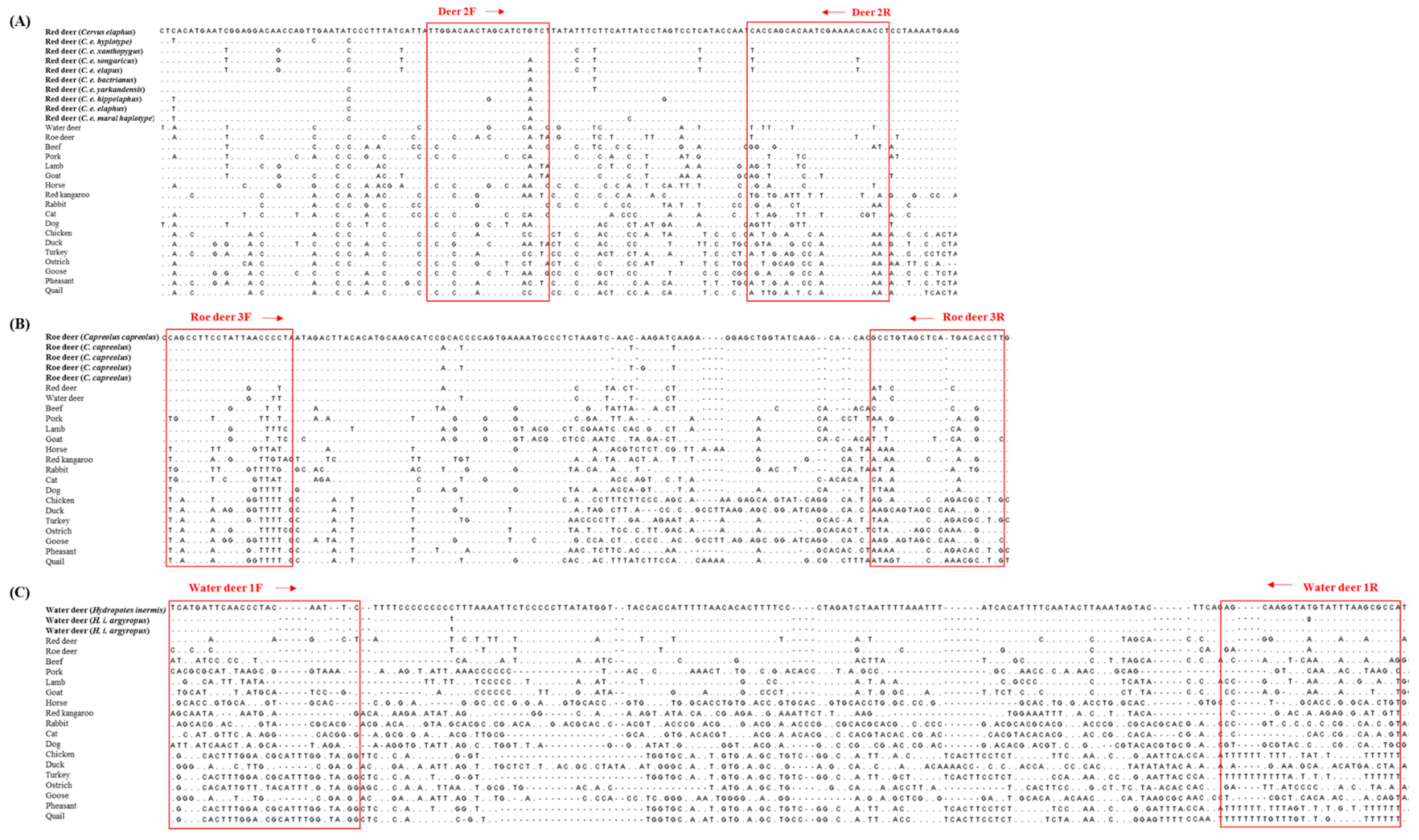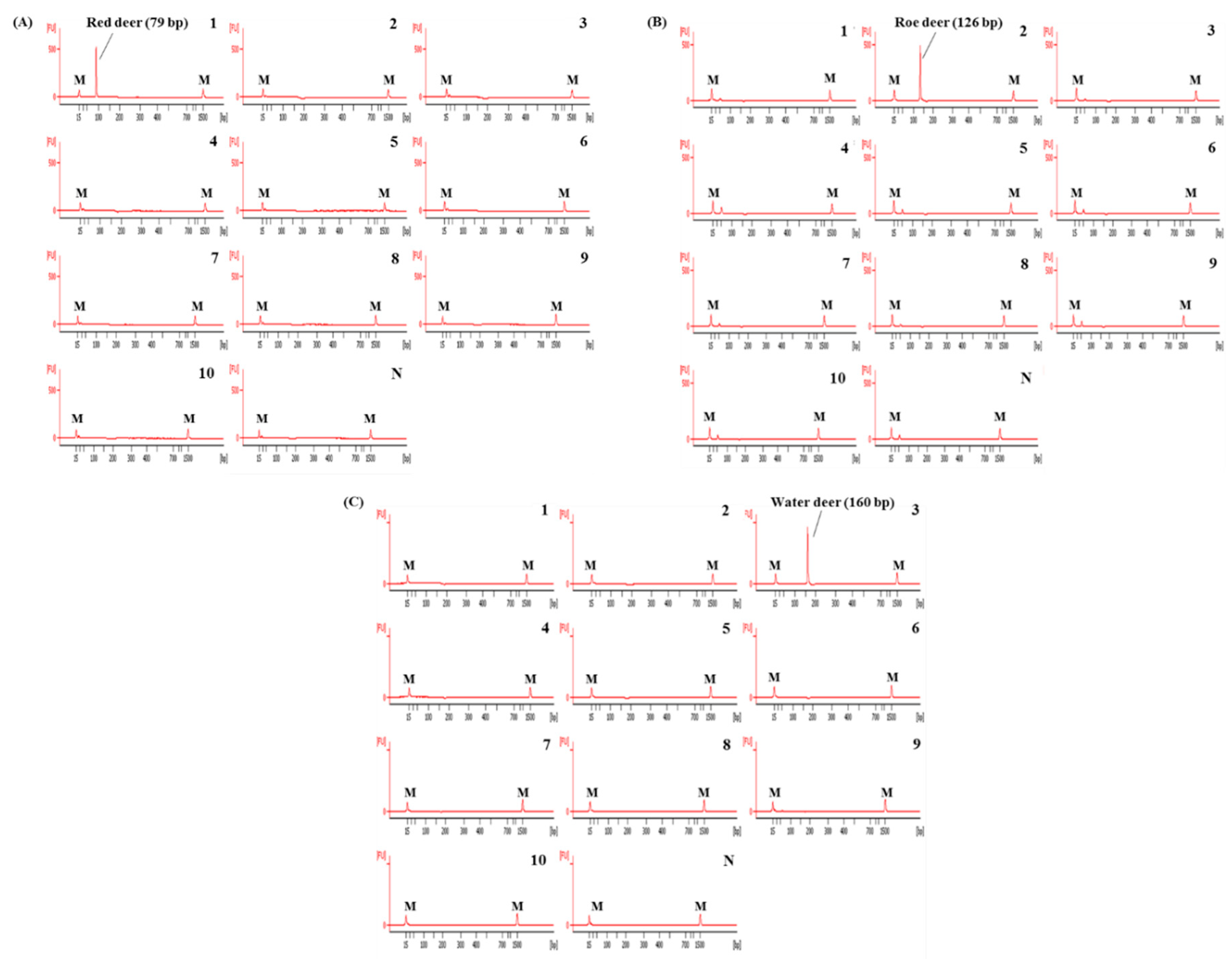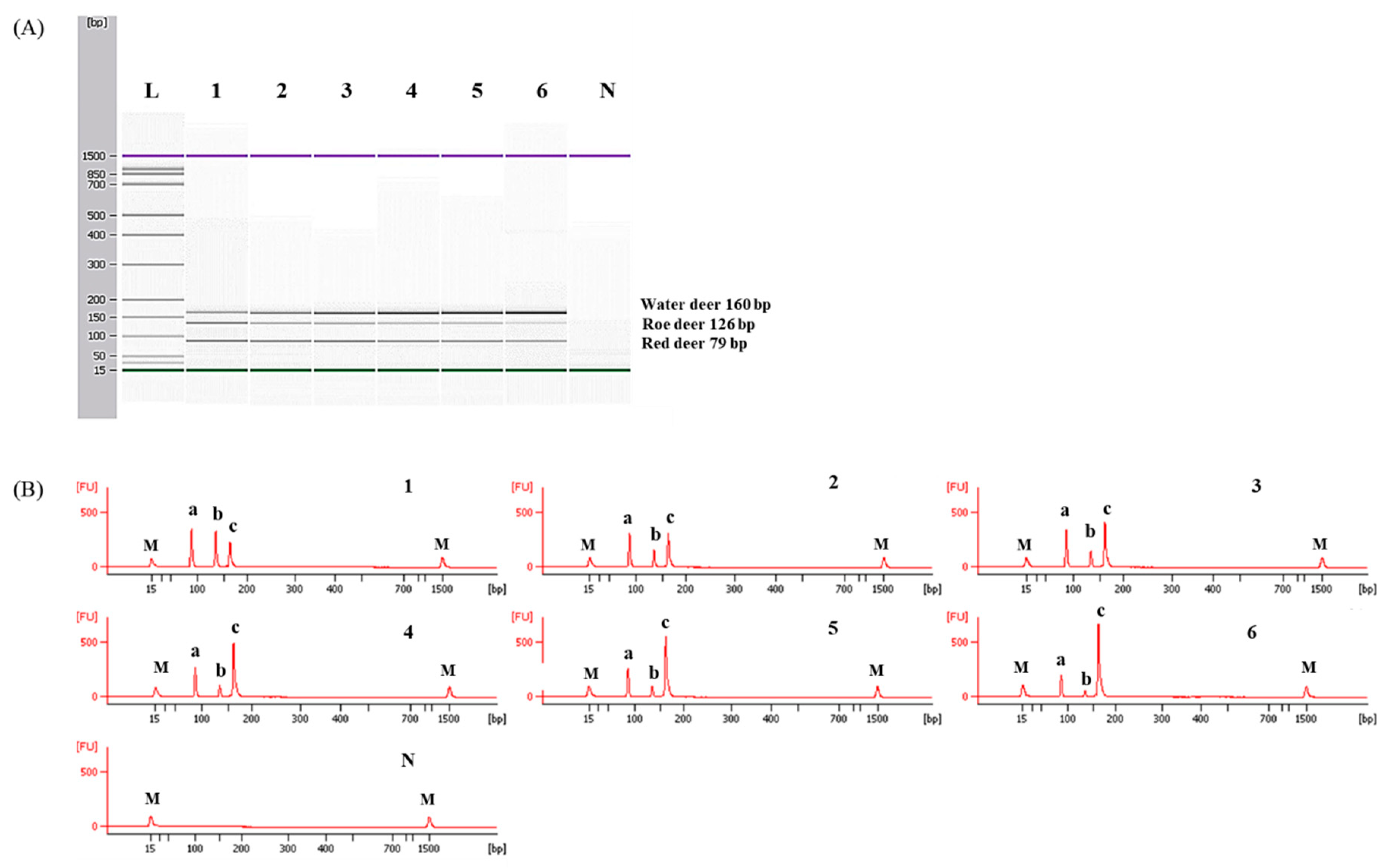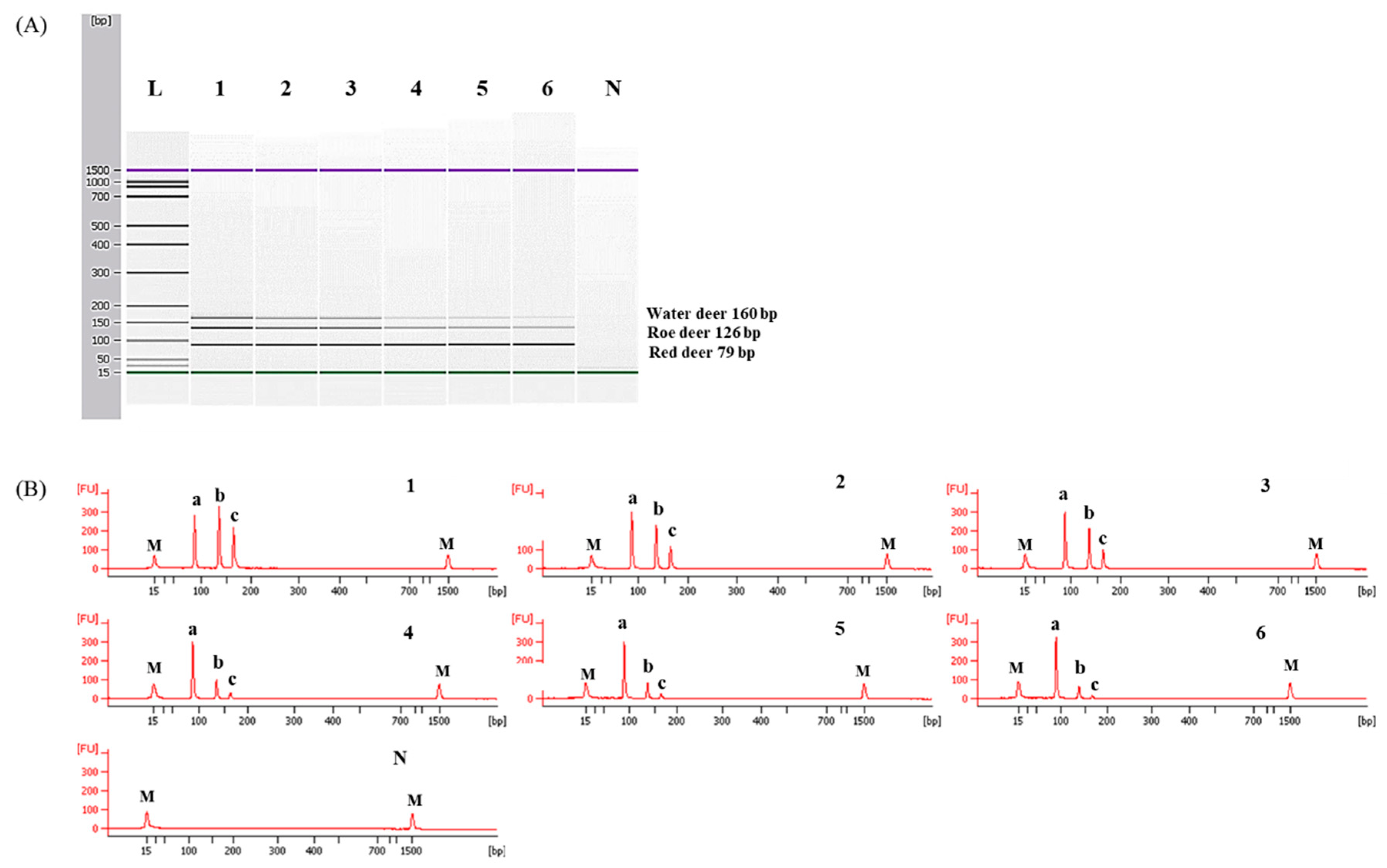Species Identification of Red Deer (Cervus elaphus), Roe Deer (Capreolus capreolus), and Water Deer (Hydropotes inermis) Using Capillary Electrophoresis-Based Multiplex PCR
Abstract
1. Introduction
2. Materials and Methods
2.1. Sample Preparation
2.2. DNA Extraction
2.3. Primer Design
2.4. Single and Multiplex PCR Conditions
2.5. Specificity and Sensitivity of Multiplex PCR
3. Results and Discussion
3.1. The Specificity of Newly Designed Species-Specific Primers
3.2. Specificity and Sensitivity of Capillary Electrophoresis-Based Multiplex PCR
3.3. Application and Validation of Capillary Electrophoresis-Based Multiplex PCR Using Meat DNA Mixtures
4. Conclusions
Supplementary Materials
Author Contributions
Funding
Acknowledgments
Conflicts of Interest
References
- Rahmati, S.; Julkapli, N.M.; Yehye, W.A.; Basirun, W.J. Identification of meat origin in food products-A review. Food Control 2016, 68, 379–390. [Google Scholar] [CrossRef]
- Kim, M.J.; Suh, S.M.; Kim, S.Y.; Qin, P.; Kim, H.R.; Kim, H.Y. Development of a real-time PCR assay for the detection of donkey (Equus asinus) meat in meat processing conditions. Foods 2020, 9, 130. [Google Scholar] [CrossRef]
- Druml, B.; Grandits, S.; Mayer, W.; Hochegger, R.; Cichna-Markl, M. Authenticity control of game meat products—A single method to detect and quantify adulteration of fallow deer (Dama dama), red deer (Cervus elaphus) and sika deer (Cervus Nippon) by real-time PCR. Food Chem. 2015, 170, 506–517. [Google Scholar] [CrossRef]
- Kaltenbrunner, M.; Hochegger, R.; Cichna-Markl, M. Tetraplex real-time PCR assay for the simultaneous identification and quantification of roe deer, red deer, fallow deer and sika deer for deer meat authentication. Food Chem. 2018, 269, 486–494. [Google Scholar] [CrossRef]
- Fajardo, V.; Conzalez, I.; Martin, I.; Rojas, M.; Hernandez, P.E.; Garcia, T.; Martin, R. Real-time PCR for detection and quantification of red deer (Cervus elaphus), fallow deer (Dama dama), and roe deer (Capreolus capreolus) in meat mixtures. Meat Sci. 2008, 79, 289–298. [Google Scholar] [CrossRef]
- Kaltenbrunner, M.; Hochegger, R.; Cichna-Markl, M. Development and validation of a fallow deer (Dama dama)-specific TaqMan real-time PCR assay for the detection of food adulteration. Food Chem. 2018, 243, 82–90. [Google Scholar] [CrossRef]
- Druml, B.; Hochegger, R.; Cichna-Markl, M. Duplex real-time PCR assay for the simultaneous determination of the roe deer (Capreolus capreolus) and deer (sum of fallow deer, red deer and sika deer) content in game meat products. Food Control 2015, 57, 370–376. [Google Scholar] [CrossRef]
- Koppel, R.; Van Velsen, F.; Ganeshan, A.; Pietsch, K.; Weber, S.; Graf, C.; Murmann, P.; Hochegger, R.; Licina, A. Multiplex real-time PCR for the detection and quantification of DNA from chamois, roe, deer, pork and beef. Eur. Food Res. Technol. 2020, 246, 1007–1015. [Google Scholar] [CrossRef]
- Kim, M.J.; Yoo, I.; Lee, S.Y.; Hong, Y.; Kim, H.Y. Quantitative detection of pork in commercial meat products by TaqMan real-time PCR assay targeting the mitochondrial D-loop region. Food Chem. 2016, 210, 102–106. [Google Scholar] [CrossRef]
- Jiang, X.; Rao, Q.; Mittl, K.; Hsieh, Y.H.P. Monoclonal antibody-based sandwich ELISA for the detection of mammalian meats. Food Control 2020, 110, 107045. [Google Scholar] [CrossRef]
- Chou, C.C.; Lin, S.P.; Lee, K.M.; Hsu, C.T.; Vickroy, T.W.; Zen, J.M. Fast differentiation of meats from fifteen animal species by liquid chromatography with electrochemical detection using copper nanoparticle plated electrodes. J. Chromatogr. B. 2007, 846, 230–239. [Google Scholar] [CrossRef]
- Varani, M.; Faccini, A.; Lambertini, F.; Suman, M.; Laporati, A.; Tedeschi, T.; Sforza, S. Species specific marker peptides for meat authenticity assessment: A multispecies quantitative approach applied to Bolognese sauce. Food Control 2019, 97, 15–24. [Google Scholar]
- Soares, S.; Amaral, J.S.; Oliveira, M.B.; Mafra, I. A SYBR Green real-time PCR assay to detect and quantify pork meat in processed poultry meat products. Meat Sci. 2013, 94, 115–120. [Google Scholar] [CrossRef]
- Kim, M.J.; Kim, H.Y. A fast multiplex real-time PCR assay for simultaneous detection of pork, chicken, and beef in commercial processed meat products. LWT-Food Sci. Technol. 2019, 114, 108390. [Google Scholar] [CrossRef]
- Ali, M.E.; Razzak, M.A.; Hamid, S.B.; Rahman, M.M.; Amin, M.A.; Rashid, N.R. Multiplex PCR assay for the detection of five meat species forbidden in Islamic foods. Food Chem. 2015, 177, 214–224. [Google Scholar] [CrossRef]
- Kim, M.J.; Yoo, I.; Yang, S.M.; Suh, S.M.; Kim, H.Y. Development and validation of a multiplex PCR assay for simultaneous detection of chicken, turkey, and duck in processed meat products. Int. J. Food Sci. Technol. 2018, 53, 2673–2679. [Google Scholar] [CrossRef]
- Kim, M.J.; Kim, S.Y.; Jung, S.K.; Kim, M.Y.; Kim, H.Y. Development and validation of ultrafast PCR assays to detect six species of edible insects. Food Control 2019, 103, 21–26. [Google Scholar] [CrossRef]
- Park, S.H.; Ricke, S.C. Development of multiplex PCR assays for simultaneous detection of Salmonella genus, Salmonella subspecies I., Salm. Eteritidis, Salm. Heidelberg and Salm. Typhimurium. J. Appl. Micobiol. 2015, 118, 152–160. [Google Scholar] [CrossRef]
- Rak, L.; Knapik, K.; Bania, J.; Sukowski, J.; Gadzinowski, A. Detection of roe deer, red deer, and hare meat in raw materials and processed products available in Poland. Eur. Food Res. Technol. 2014, 239, 189–194. [Google Scholar] [CrossRef]
- Hou, B.; Meng, X.; Zhang, L.; Guo, J.; Li, S.; Jin, H. Development of a sensitive and specific multiplex PCR method for the simultaneous detection of chicken, duck and goose DNA in meat products. Meat Sci. 2015, 101, 90–94. [Google Scholar] [CrossRef] [PubMed]
- Kim, M.J.; Kim, H.Y. Species identification of commercial jerky products in food and feed using direct pentaplex PCR assay. Food Control 2017, 78, 1–6. [Google Scholar] [CrossRef]
- Kitpipit, T.; Sittichan, K.; Thanakiatkrai, P. Direct-multiplex PCR assay for meat species identification in food products. Food Chem. 2014, 163, 77–82. [Google Scholar] [CrossRef] [PubMed]
- Lin, W.F.; Hwang, D.F. A multiplex PCR assay for species identification of raw and cooked bonito. Food Control 2008, 19, 879–885. [Google Scholar] [CrossRef]
- He, H.; Hong, X.; Feng, Y.; Wang, Y.; Ying, J.; Liu, Q.; Qian, Y.; Zhou, X.; Wang, D. Application of Quadruple Multiplex PCR Detection for Beef, Duck, Mutton and Pork in Mixed Meat. J. Food Nutr. Res. 2015, 3, 392–398. [Google Scholar] [CrossRef]
- Hossain, M.M.; Ali, M.E.; Hamid, S.B.A.; Mustafa, S.; Desa, M.N.M.; Zaidul, I.S.M. Targeting double genes in multiplex PCR for discriminating bovine, buffalo and porcine materials in food chain. Food Control 2017, 73, 175–184. [Google Scholar] [CrossRef]
- Suh, S.M.; Kim, M.J.; Kim, H.I.; Kim, H.J.; Kim, H.Y. A multiplex PCR assay combined with capillary electrophoresis for the simultaneous detection of tropomyosin allergens from oyster, mussel, abalone, and clam mollusk species. Food Chem. 2020, 317, 126451. [Google Scholar] [CrossRef]






| Target Species | Primer Name | Sequences (5′ → 3′) | Target Genes | Amplicon Size (bp) | Accession No. |
|---|---|---|---|---|---|
| Red deer | Deer 2 F | TGGACAACTAGCATCTGTCT | cyt b | 79 | JF489133.1 |
| Deer 2 R | GAGGTTGTTTTCGATTGTGCTGGTG | ||||
| Roe deer | Roe deer 3 F | CAGCCTTCCTATTAACCCCT | 12 S rRNA | 126 | KJ681490.1 |
| Roe deer 3 R | AGGTGTCATGAGCTACAGGC | ||||
| Water deer | Water deer 1 F | CATGATTCAACCCTACAATTC | D-loop | 160 | NC011821 |
| Water deer 1 R | GGCGCTTAAATACATACCTTGCT |
| The Ratio of Meat DNA Mixtures (%) | |||
|---|---|---|---|
| Red Deer | Roe Deer | Water Deer | |
| Roe deer and water deer in red deer | 80 | 10 | 10 |
| 90 | 5 | 5 | |
| 98 | 1 | 1 | |
| 99 | 0.5 | 0.5 | |
| 99.8 | 0.1 | 0.1 | |
| Red deer and roe deer in water deer | 10 | 10 | 80 |
| 5 | 5 | 90 | |
| 1 | 1 | 98 | |
| 0.5 | 0.5 | 99 | |
| 0.1 | 0.1 | 99.8 | |
© 2020 by the authors. Licensee MDPI, Basel, Switzerland. This article is an open access article distributed under the terms and conditions of the Creative Commons Attribution (CC BY) license (http://creativecommons.org/licenses/by/4.0/).
Share and Cite
Kim, M.-J.; Lee, Y.-M.; Suh, S.-M.; Kim, H.-Y. Species Identification of Red Deer (Cervus elaphus), Roe Deer (Capreolus capreolus), and Water Deer (Hydropotes inermis) Using Capillary Electrophoresis-Based Multiplex PCR. Foods 2020, 9, 982. https://doi.org/10.3390/foods9080982
Kim M-J, Lee Y-M, Suh S-M, Kim H-Y. Species Identification of Red Deer (Cervus elaphus), Roe Deer (Capreolus capreolus), and Water Deer (Hydropotes inermis) Using Capillary Electrophoresis-Based Multiplex PCR. Foods. 2020; 9(8):982. https://doi.org/10.3390/foods9080982
Chicago/Turabian StyleKim, Mi-Ju, Yu-Min Lee, Seung-Man Suh, and Hae-Yeong Kim. 2020. "Species Identification of Red Deer (Cervus elaphus), Roe Deer (Capreolus capreolus), and Water Deer (Hydropotes inermis) Using Capillary Electrophoresis-Based Multiplex PCR" Foods 9, no. 8: 982. https://doi.org/10.3390/foods9080982
APA StyleKim, M.-J., Lee, Y.-M., Suh, S.-M., & Kim, H.-Y. (2020). Species Identification of Red Deer (Cervus elaphus), Roe Deer (Capreolus capreolus), and Water Deer (Hydropotes inermis) Using Capillary Electrophoresis-Based Multiplex PCR. Foods, 9(8), 982. https://doi.org/10.3390/foods9080982






